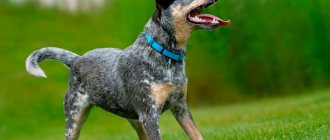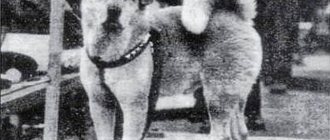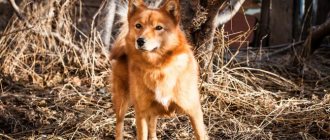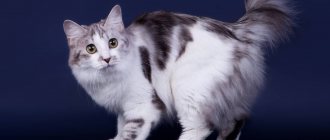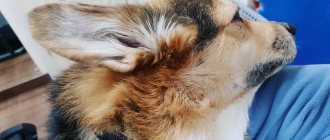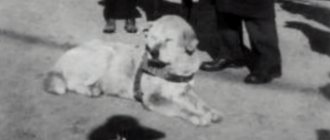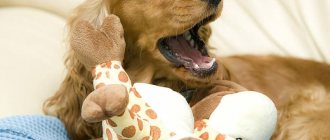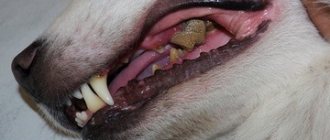Mastiffs are a family of breeds that include Tibetan, Argentinean, Spanish, American, Brazilian, Pakistani, Japanese and other varieties.
The Major Mastiff is a breed of dog with a stable psyche, very balanced and friendly.
She is not at all as evil and bloodthirsty as she is portrayed to be.
Only those representatives who did not undergo socialization and education in time are responsible for such rumors.
In general, the ca-de-bo, although it cannot be called sociable, will easily fit into any family.
In this article you will find a detailed description of this breed, which will help you decide whether it is suitable for you or not.
History of appearance
In the 18th century, Spain was a colony of England. The British brought their own entertainment to the country, one of which was bloody bullfights, which later developed into bullfighting.
At that time, bullfighters had to appear on the field in front of the bull and the dog. But in Mallorca there were no suitable breeds - the herding dogs caused irreparable harm to the bull and there was no show, and the guard dogs were too slow and quickly died.
For this reason, there was a need for baiting dogs. The Old English Bulldog was able to satisfy this need.
Also, the appearance of ca-de-bo is associated with the shepherd ca-de-besti-ara. It is known that bulldogs at that time had a nasty and evil character. It was for this reason that it was decided to cross the breed with “shepherds”, because with the help of this it would be possible to achieve a more balanced dog in character, capable of baiting.
Kadebo began her gladiatorial career, but at the same time she faced a very serious selection process.
Only the female was involved in giving birth to puppies and raising them, and this made the breed an excellent parent. But at the same time, females who experienced problems during childbirth simply died.
Aggression towards the owner was considered unacceptable, and animals that showed it were destroyed.
Also, the mastiff has never been vaccinated. He was unprotected against viral diseases; even after the battle, no one took care of the dogs’ health - they simply died from wounds or diseases. Thus, natural selection allowed only a few representatives of this breed to survive, but these units were the strongest, smartest and most balanced.
By the end of the 19th century, the breed almost disappeared. Only a few dozen Major Mastiffs have survived. To recreate the breed, Ca-de-Bestie-Ara and preserved Old English Bulldogs were again used.
NOTE!
Currently, all problems with breeding Major Mastiffs have been practically eliminated. The vast majority look like purebreds and the very first ca-de-bos.
Interesting facts about the breed:
- The breed also has a second name - Perro Dogo Mallorquin, which literally translates as “bulldog dog from Mallorca”; the name is also known as bull dog;
- During the revival of the breed, breeders paid great attention to the height and size of dogs. Too small indicated a predominance of bulldog genes, and too large indicated a predominance of shepherd genes. Hundreds of puppies were rejected, but those selected could successfully continue to participate in breeding work;
- If you look at a modern Ca de Bou and a photograph of an 18th century Old English Bulldog, you will notice that the Mastiff has much more in common with it than the modern Bulldog.
Origin story of Ka De Bo
The first information about mastiffs dates back to the 17th century. Then their images appeared on the walls of the bullring in Mallorca. It was there that most of the representatives of this breed, whose name Ca de Bou translated as “bull dog,” were located. They participated with the bullfighter in a fight with a bull and fiercely defended the man.
There is more than one version of the origin of the breed. The first says that their ancestors were English bulldogs, which were brought to the island by the British in the 16th century. Another version claims that these dogs were brought from the campaigns by the knights of the Order of Malta. Be that as it may, in Malta these dogs began to be crossed with Major Shepherds to improve the breed.
Mastiffs were used not only for bull fighting, but also for protection; they accompanied travelers during their travels and robbers during raids, herded livestock, and served as hunting dogs. But after the ban on bullfighting, these dogs, despite their employment in many fields of activity, found themselves on the verge of extinction .
The breed was literally restored in the 20th century by dog handlers. This work involved mastiff-like dogs preserved on peasant farms, Staffordshire bull terriers, and Malorese shepherd dogs. The breed was registered in 1965 and received the full name Perro Dogo Mallorquin or Ca de Bou.
Description of the breed
Ca-de-bo has a strong build and a slightly elongated body. People who see a Molosser for the first time will be surprised by its extraordinary plasticity and mobility.
The dog has a wide and powerful muzzle, the ears are pink-shaped - they are broken in the cartilage and open the ear canal. The tail is low set and tapers from base to tip. The hind limbs are stronger than the forelimbs. The coat is short, several colors are allowed.
Despite their menacing appearance, the dogs are quite good-natured. They are devoted to their owner and will never show aggression towards him. In the family, they do not single out one person, but give love to everyone in the family indiscriminately.
IMPORTANT!
Despite the docile nature, few beginners can cope with such a serious breed, because it needs an authoritative owner with a strong character.
Character and temperament
Positive characteristics of Ca de Bou:
- calm,
- balanced temperament,
- brave,
- communicable,
- silent,
- loyal and devoted to the owner,
- sensitive to the state of the owner.
Negative features:
- excessive phlegmaticity
- timidity and uncontrollable aggressiveness are considered disqualifying faults according to the breed standard.
Character traits
The Major Mastiff is a very calm and balanced breed , and stories about aggression and anger are associated with the fact that dogs are not socialized in society in a timely manner and do not receive proper education.
The Mastiff does not require much attention. He is quite phlegmatic by temperament, and in the absence of his owner he will simply silently wait for him at the doorstep. When the owner is nearby, the ca-de-bo will happily settle down at his side or near his feet and will look at the person with adoration and devotion.
Despite its friendliness, this breed is not suitable for everyone. She can be willful and stubborn, especially as a puppy during upbringing and training. The Mastiff needs a person with a strong character, who would be internally stronger than the dog. If the dog feels authority, he will be imbued with respect for such an owner and consider him to be the leader and the main thing.
Ca-de-bo has high watchdog and security potential. It is wary of strangers, but will not attack unless there is a direct threat to a family member or territory, and also if the owner does not give a command. The dog will look at the stranger for a long time, expecting a trick, but no more.
The Mastiff loves to play and needs long walks outside as well as some exercise. For example, the animal loves to play frisbee.
Expert opinion
Kozhevin Semyon Kirillovich
Expert dog handler.
“On the surface, the dog appears to be a threat. In fact, properly raised Major Mastiffs have a very restrained character when walking and are difficult to anger. A reaction can occur if the dog feels a real threat from someone or something. Next to family, even children, the dog will be affectionate and calm. They love to be around “their” people. Loneliness is tolerated well, the main thing is to have a favorite toy, food and water nearby.”
Owner reviews
Kate
Our family is the happy owner of a Ca de Bou dog. Our pet Argo has been living with us for 4 years now. Despite her small size for a large dog, she feels great in our apartment. This is a very kind animal that always treats children with affection. As soon as a child starts crying, the first person who rushes to his aid is our pet. Argo is very easy to care for with his short coat. He is not picky about food and enjoys eating porridge with meat. After a walk, you don’t have to force him into the bath to wash his paws off the dirt. We have never seen any signs of aggression from him; our pet is even friendly towards strangers.
Irina
Kadebo is an ideal dog for a city dweller who is always busy and a little lazy: it does not require long walks. She is comfortable in a country house. Doesn't take up much space, gets along great with children. Not slobbering.
Peter
I had two other breeds before Ca de Bou, but now I understand that after Ca de Bou I will only have Ca de Bou. This breed has only one drawback: it penetrates the soul and fills it.
Lisa
When I found out about this breed, I didn’t find a single negative review about it, so I decided to get this particular dog. But to please our daughter, who dreamed of an Amstafa, we chose a black Ca de Bou, which slightly resembles an Amstafa. My daughter liked my decision. It’s already been 5 months since this girl has been living in our apartment, and my daughter already treats her differently. If we want to get another dog, it will definitely be a Kadeboshka. Dami has become a new member of our family whom we love very much. This is an excellent option for an apartment, because it is small in size, very obedient and incredibly loyal.
Alexei
My Largo is a godsend for an apartment, because with its large size, it is almost invisible at home. In his free time he just lies quietly on the sofa, sleeping. But when someone comes, it’s just a hurricane of joy and happiness. The breed has several disadvantages: it sheds, and short hair is difficult to remove from things. Also, great stubbornness; if you decide to chew on a table or a corner of a wall, you will chew no matter what you do. And lastly, Largo cannot have a large list of products, because the breed is very allergic. There is only special food, very expensive. Otherwise, he is a wonderful dog, not evil, but his appearance inspires respect, the neighbors are afraid to ride in the elevator with us. On the street, Largo is accustomed to walking next to him, since holding almost fifty kilograms is not easy even for me!
Oleg
A Ca de Bou girl named Nessie has been living with us for a year and a half. She is very, very active, loves to misbehave and rush around the playground with other dogs. Peace-loving and gentle, absolutely not aggressive towards children. But when they came to install a sink, she rushed at the plumber, although she had never shown watchdog skills before. At the training ground he does almost all the commands, but only if he has a good run before the lesson. The level of activity on the street is simply enormous, although at home he usually behaves very quietly, mostly sleeping. At the exhibition, however, she showed herself excellently, won the title “Best Junior” and even won best!
Leonid
This dog came to us recently - only 2 months ago. We took him in as an adult puppy, when he was 6 months old, but we still found a common language with him. I would like to express special gratitude to the breeder who taught him the basic commands. But we continue to train him ourselves. We are literally amazed at how quickly she picks things up. She especially likes to play. We often go somewhere with her to play ball and try to catch up with each other. At such moments, the dog looks especially happy, it seems that a smile appears on his face. At the same time, it is an excellent guard. He reacts perfectly to any person who walks along the entrance and emits a menacing growl. However, a couple of moments pass, and she again becomes a calm and good-natured dog.
Video
Advantages and disadvantages
Advantages:
- Sentry and security potential;
- You can walk without a leash because the dog is not aggressive;
- Loyal to the whole family, has no favorites;
- Loves children;
- Stable psyche;
- Good health;
- Endurance;
- Easy care and unpretentiousness in food;
- No drooling or heavy shedding.
Negative sides:
- Likes to dominate;
- Submits to a person with authority;
- It is very difficult to buy and find a puppy that meets the standard.
Breed characteristics and character traits
Despite their fighting past, these dogs are not at all aggressive. They are loyal to their owner, friendly towards his family members, and love children. They are wary of strangers and take a long time to get used to them. It is obvious that ca-de-bo are excellent guards and defenders. Pets bark only when necessary, when there are clear reasons for alarm.
The Major Mastiff is characterized by high intelligence, is well trained and trainable. The dog is very active, loves outdoor games and long walks. Treats other pets in the house calmly, while maintaining a dominant position without showing aggression or physical violence. The animal's behavior is aimed primarily at defense rather than attack. Cadebo dogs do not need a lot of attention from the owner.
Accepted standard
Ka-de-bo has a strong build, a square head, and a furrow on its forehead. The muzzle is cone-shaped, equal to two-thirds the size of the skull. The nose is black, the eyes are large and oval. Can only be dark colors.
The ears are pink.
The Mastiff has a bulldog bite, which is why the bite force of representatives of the breed is strong, and a powerful neck with a slight dewlap.
The body is Molossian, that is, rectangular. The lower back is narrow, the stomach is tucked. The tail is set low and tapers to the tip. The forelimbs are parallel and slightly weaker than the hind limbs.
The coat is short and hard, without undercoat. The dog moves at a trot, alternately rearranging pairs of limbs diagonally.
NOTE!
There are also disqualifying defects: atypical ears, scissor or straight bite, bulldog tail, light iris, undershot, cropped ears or tail, etc.
Breed standard
The latest edition of the current standard was adopted on December 11, 1996. Ca de Bou occupy a place in group 2 “Pinchers and Schnauzers, Molossians, Swiss Mountain and Cattle Dogs”, section 2.1 “Dogs of the Molosser and Mastiff type” under number 249. The main purpose is guard and a security guard.
Temperament
The standard establishes the following behavioral qualities of ca de bou:
- calmness and self-confidence;
- contact;
- loyalty and devotion to the owner;
- courage and fearlessness in certain circumstances;
- unsurpassed security and guard qualities.
In an excited state, the dog's appearance and behavior become threatening.
Appearance
The standard describes a strong and powerful dog of medium height, which has the following appearance characteristics:
- The head is powerful. Males differ from females by having a larger head.
- The skull is square, in diameter greater than the height of the dog at the withers.
- The forehead is wide and flat with a clearly visible groove in the middle. The stop at the transition from the forehead to the muzzle is clearly pronounced.
- The nose is wide and black.
- The muzzle is wide and has the shape of a blunt cone. Its length correlates with the skull in a ratio of 1:3.
- The teeth are not visible when the mouth is closed. The bite is an undershot, the indentation should not be more than 1 cm.
- The eyes are large, oval, set slightly obliquely, widely spaced. Color - as close as possible to the color.
- The ears are small, located high and on the sides. Slightly raised and looking back, forming a “rose”. At rest, the tips hang below eye level.
- The neck is thick, almost the same diameter as the head. The skin is slightly loose.
- The chest is wide, the stomach is tucked.
A large head, a powerful neck, a wide chest are the main breed characteristics of the Ca de Bou.
- The croup is up to 2 cm higher than the height at the withers.
- The tail is set low, thick at the base, tapering to the tip.
- The legs are muscular, straight, strong. Pigmentation of the pads is preferred, but little pigmentation on the front feet.
- The coat is short and harsh.
- Color in order of preference: brindle in dark tones, fawn (fawn) with deep tones, black. White spots on the front legs, chest and face (no more than 30% of the total color) and a black mask on the face are acceptable.
Among the Ca de Bou, the most prized color is the brindle color in dark tones.
Height:
- males - 55–58 cm;
- females - 52–55 cm.
Body mass:
- males - 35–38 kg;
- females - 30–34 kg.
Disadvantages and disqualifying vices
Any deviation from the standard is assessed as a deficiency. Serious ones include:
- height at the withers exceeding the height of the croup;
- another type of bite and overshot of more than 1 cm;
- absence of 2 premolars;
- ears that do not meet the standard;
- tail like a bulldog.
Vices for which a dog faces disqualification:
- light or yellow eyes;
- undershot;
- cropped ears and tail;
- white color occupying more than 30% of the body, or white spots located in places other than those specified in the standard;
- spots on the body of a different color;
- aggressiveness or cowardice.
Photos with examples of colors
The Major Mastiff can be of the following colors:
- Brindle – dark and light colors are acceptable;
- Red – this includes fawn and fawn. Shades should be saturated;
- Black.
The standard also allows white points as long as they do not occupy more than a third of the body area. Some representatives have a barely noticeable mask.
Is it suitable for keeping outdoors or in an apartment?
A dog can live equally on the street and in an apartment.
She will be more comfortable in the area, so she can realize her guard instinct. Moreover, the dog will be able to run, which means some part of his need for activity will be fulfilled. The downside is that you will have to bring the dog indoors for the winter. Due to the lack of undercoat, she will not be able to tolerate low temperatures.
In an apartment, a mastiff does not destroy furniture. It is neat, but in this case, you will have to spend a lot of time with your pet outside.
Does he get along with children and get along with other pets?
The breed gets along very well with children. She loves kids and enjoys spending time with them. The dog is ready to endure various tugging and squeezing for a long time, but the game should always take place under the supervision of adults, no matter how confident you are in your pet.
The mastiff also gets along well with other animals, especially if he grew up next to them. The attitude of a dog that has successfully completed socialization will be lenient.
IMPORTANT!
The dog can be dangerous to children he doesn't know. The Major Mastiff will not tolerate the same attitude from strangers that is acceptable for a domestic child.
How to properly care?
Caring for the ca-de-bo is simple, but must be thorough:
- Brush the coat twice a week using a furminator. This should be done more often during the period of active molting;
- To avoid dog smell, you should, oddly enough, bathe your dog as rarely as possible. Buy shampoos specifically for wire-haired dogs;
- Inspect your ears as often as possible, and wipe them with a cotton swab every 2-3 days;
- Eyes need to be cleaned every week;
- The Ca-de-Beau has a snack, and this contributes to the formation of tartar. Inspect your mouth, and it would also be a good idea to purchase special means for its prevention. Also brush your dog's teeth;
- Nails need to be trimmed as they grow. On average, this procedure is done once a month;
- You need to walk your dog several times a day, for long periods of time, to satisfy its need for physical activity.
Dry food also helps prevent the formation of tartar.
Character of the breed
When they first see this dog, many people think that it was created only to participate in fights with its relatives and is not capable of affection. In fact, modern ca de bou are very sweet and even loving creatures.
They adapt well to different environmental conditions. These are very active dogs, so they will get involved in all family activities and are very happy if they are invited to play together. The dogs are quite self-possessed, patient, even during a walk, if they meet other relatives, they will not succumb to provocations and enter into a fight.
Ca de bou are excellent guards of property and people. Moreover, they are always ready to warn about danger, but barking for no reason is not typical for them.
The desire to move is so strongly developed in them that sometimes the owners get tired of it. However, you should show restraint and allow the dog to splash out its energy during a walk.
They will be happy to accompany their beloved owner on his travels, even if it involves a lot of walking.
The Ca de Bou dog breed is highly trainable. Accepts commands quickly, but only through encouragement. If you are rude to her, if you hurt her, she will harbor a grudge. The training course should include various jumps, which the Majorcan Bulldog really likes.
Gets along great with children. A dog is capable of not only protecting them, but also raising them. There are no problems in her living together with other animals. True, most likely, she will try to take the place of leader among other pets.
Nutrition and care
If you have an idea of how a dog is usually cared for, then it becomes clear that the Ca de Bou is a very comfortable type of pet. It is enough to brush the wool once a week. There is no need to wash the dog. Considering that she loves to swim, she can be given the opportunity to swim to her heart's content in the summer.
Nails should be trimmed approximately once every two weeks. It is necessary to check the condition of the eyes and ears in order to detect possible inflammation in time. They also check skin folds for diaper rash or other damage that can cause more serious skin diseases.
The dog should be fed twice a day. You should not follow her lead in terms of choosing foods, otherwise this will lead to an imbalance in nutrition. She may gain excess weight, but this is of no use.
Many owners in modern society try to provide ready-made food and clean water. If you want to feed more natural food, then you need to cook meat, chicken, soups and cereals. It is better to give porridge in the morning so that the dog has energy. After long walks, protein foods are better, which will allow muscles to develop more actively.
The Major Bulldog gets sick more rarely than other breeds, but with age, problems with vision, hearing or joints are possible, so an adult dog should be regularly shown to veterinarians. In a city apartment, the dog must have its own place where the Major Bulldog will happily hide toys.
The dog is perfect for a family with children, as well as for anyone who wants to have a devoted friend and ally.
Life expectancy and major diseases
The average lifespan of a mastiff is 10-14 years.
The main diseases to which the animal is susceptible:
- Digestive tract sensitivity;
- Possible manifestation of food allergies;
- Dysplasia of the elbow and hip joint;
- Hepatopathy;
- Demodectic mange;
- Myositis;
- Otitis.
Health and life expectancy
Representatives of the breed live on average 10-14 years .
Ca de Bou are considered healthy dogs; they do not have specific genetic defects. Common diseases include:
- hip dysplasia;
- knee diseases;
- pathologies of the gastrointestinal tract - a rather sensitive stomach;
- tendency to allergic reactions; heart disease;
- oncological diseases;
- otitis.
When choosing a puppy from a nursery, you cannot get one hundred percent health guarantees, but experienced breeders recommend requesting veterinary certificates about the health status of the parents. A family history of dysplasia is a risk factor for the development of this disease in a young dog.
Nutritional Features
Breeders equally recommend both natural food and industrial food. When choosing food for your pet in the store, you need to choose the right brand and quality of food - premium, super premium or holistic.
If you decide to feed natural food, then you need to know:
- The diet should consist of two thirds meat. It should be lean - veal or beef;
- You can give offal, as well as boiled sea fish, but not often;
- Fruits and vegetables will be useful in the diet, but here you need to be careful not to cause allergies;
- You can give eggs, cereals and dairy products.
Fatty, salty, sweet, smoked, pickled, river fish, berries, whole milk, and tubular bones should be completely excluded from the dog’s diet.
NOTE!
Remember that feeding natural food should be accompanied by taking vitamin supplements.
You need to feed twice a day, and the dog should always have access to water.
Care and maintenance
A dog of the Ca de Bou breed at a small age needs to reduce the load on the joint; the growing body cannot cope with heavy loads; the pet should not be allowed to go down the stairs on its own for up to 4 months, and jumping from heights should be avoided.
- Wool: comb with a brush 2 times a week, every day during the shedding period, with a slicker brush.
- Bathing: as the animal gets dirty, using only veterinary shampoos. Dry with a regular terry towel. The water should not be hot. For everyday care, washing the paws and drying the fur with a damp cloth after a walk is suitable.
- Nails: accustom the puppy to the procedure from 2 - 3 months, cut the nails with a nail clipper 1 - 2 times a month, dogs with sufficient physical activity often grind them off on their own.
- Teeth: brush with a special brush using a veterinary product, do not use human paste and in no case hydrogen peroxide, all tooth enamel will be damaged, and the product may get inside, this is an erroneous recommendation from unreliable sources. It is recommended to use bones - delicacies that remove plaque well and help improve digestion.
- Eyes and ears: wipe at least 2 times a week, eyes 2 times a week. A cotton pad with chamomile infusion is suitable, or a special lotion for the ears, which is sold in veterinary stores.
- Vaccinations and vaccinations according to age - regularly, in a timely manner. During the season - wool treatment for parasites, once every six months for adults - anthelmintic. Puppies can eat once every three months.
- Daily physical activity is required, walking 2 times a day for an adult dog, 4 times a day for a puppy, you can leave a disposable diaper at home until the baby gets used to walking. Give teenagers and adults the opportunity to run and play freely without a leash.
- Before the puppy arrives at its new home, prepare in advance: toys, bowls, collar and leash, toys and food. Choose a place for your pet, equip it with soft bedding.
- It is recommended to remove small objects, wires, plugs and cords, shoes and everything that he can reach. Prepare for the fact that the puppy will chew everything he comes across; it is better to stock up on a sufficient number of toys that can be used.
They are able to live both in city apartments and in private houses. The dog cannot live exclusively on the street, but in the summer it can be transferred to an enclosure in the yard.
Diet
The Ca de Bou or Major Mastiff must receive a well-balanced and highly nutritious diet. For them, premium food is suitable, which already contains all the necessary elements.
It is not recommended to feed a mixed type of food: only dry food or natural food.
The complexity of natural feeding lies in its organization; it is important not only to correctly calculate the daily intake of protein, but also carbohydrates, fats, and additional vitamins and mineral complexes.
Calculation of nutrition for natural feeding: 30 grams of protein per 1 kg of animal + 30% carbohydrates and vegetables.
- You can give:
- Low-fat veal, beef, chicken, turkey, rabbit;
- Porridges and cereals: rice, buckwheat, barley, oatmeal;
- Vegetables: zucchini, cucumber, carrots, beets, pumpkin, cabbage, chopped or grated corn;
- Viscera: tripe, lung, liver;
- Fruits: apples, bananas, pears, grapes;
- Dairy products: cottage cheese, kefir, fermented baked milk, all low-fat;
- Bone meal and vegetable fats;
- Fish: sea, cleaned.
Forbidden:
- Human food from your table;
- Tubular bones;
- Chicken bones;
- Sweet;
- Flour;
- Bread;
- Citrus fruits, plum;
- Salty, fried, spicy, peppery.
Adults eat 2 times a day - morning and evening, puppies eat 4 times a day in small portions. When feeding dry food, there must be access to drinking water.
- As goodies: chopped cheese, boiled chicken breast, special bones.
Dog training
Successful training can only be achieved with the right approach. If you have little experience, then contact a kennel club, where you and your pet can take special training courses.
You should not encourage your dog to be aggressive, so harsh training methods are not acceptable. On the contrary, you must build a trusting relationship with your pet; remember that the breed cannot be re-educated.
Do not forget that the dog must go through the stage of communication not only with humans, but also with other dogs.
How to choose a puppy?
The first step is to choose the right nursery. Study them carefully and focus only on specialized and confirmed ones.
When choosing a puppy, pay attention to the following:
- The puppy should be 1.5-2 months old;
- A bump on the head - the larger it is, the larger the dog will be in the future;
- There should be no bald spots on the coat, mucous membranes should be free of discharge and odor, and the tail should be free of kinks and deformations;
- A healthy puppy does not show aggression or cowardice. He is moderately curious and playful.
Also check all documents for the puppy and vaccination certificates.
Choose your sex, remember that males are more capricious. It will be more difficult to train and raise them. Females are docile and affectionate, but in the future you will have to face pregnancy and childbirth if you do not sterilize your dog on time.
Price range and nurseries in Russia
The price of a Major Mastiff depends on many factors. On average, a puppy costs from 50 thousand rubles. Mixed breeds or defective puppies will cost 10-15 thousand rubles.
The following nurseries of this breed are located in Russia:
- Moonlight Sonata;
- Rus Kauri;
- Alferor;
- Ideal Dogs;
- Miedo Del Toro.
